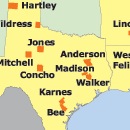Impact on demographic data
The miscount of incarcerated people creates a multitude of problems for people who use census data for planning and research purposes. Counting large populations of incarcerated people as local residents leads to misleading conclusions about the size and growth of communities.
Recent research has shown that correctional facilities are increasingly located in areas that are geographically and demographically far removed from the communities to which most incarcerated people belong. According to Department of Agriculture Demographer Calvin Beale, although most incarcerated people are from urban areas, 60% of new prison construction takes place in non-metro regions.
Crediting large numbers of incarcerated people to the often sparsely populated counties that contain prisons leads to misleading conclusions about the size, nature and growth of communities.
 In 21 counties, at least 21% of the population reported in the U.S. Census is incarcerated people, not local residents. In Crowley County, Colorado and West Feliciana Parish, Louisiana, a full third of the population is incarcerated. It is in these counties where the Census is the least able to descibe the county's actual residents. These aren’t necessarily the most punitive counties in the U.S., they just house a large number of incarcerated people.
In 21 counties, at least 21% of the population reported in the U.S. Census is incarcerated people, not local residents. In Crowley County, Colorado and West Feliciana Parish, Louisiana, a full third of the population is incarcerated. It is in these counties where the Census is the least able to descibe the county's actual residents. These aren’t necessarily the most punitive counties in the U.S., they just house a large number of incarcerated people.
Large problems can be caused by even smaller incarcerated populations. The city of Waupun, Wisconsin commissioned a study to fix the Census’ prison miscount. The data provided by the Census Bureau, describing the residents, from their educational attainment to income and race, did not paint a reliable picture of the city's population. Gary Rogers, Waupun city administrator, stated that:
“We needed real numbers. Any commercial development, any retail development, looks at the disposable income of the population. With our prisons, it meant we were almost always way outside their numbers.”
Distorting growth:
- Some counties’ reported population growth is due to the importation of incarcerated people to a new correctional institution. In the 1990s, 30% of “new residents” to upstate New York “didn’t make the trip by choice, and they didn’t move into subdivisions or houses on secluded cul-de-sacs. They were inmates making their new homes in prison cells.”.
 Nationally, 56 struggling counties appeared to be healthy and growing during the previous decade only because the Census Bureau counted new prison cells as new residents. In actuality, these 56 counties saw population decline.
Nationally, 56 struggling counties appeared to be healthy and growing during the previous decade only because the Census Bureau counted new prison cells as new residents. In actuality, these 56 counties saw population decline.- And when a prison suddenly closes and the population drops a community will appear to be in more significant distress than it actually is.
Distorting race & ethnicity:
- In 173 counties, more than half of the Black residents reported in the Census are actually incarcerated people.
- It’s hard to tell whether Hispanics are migrating to rural areas by choice or if it’s just another distortion caused by the prison miscount.
Distorting gender:
- 92% of incarcerated people are men. Determining the true gender ratios — and portion of the population that is married — is difficult in the prison counties and all but impossible in urban communities with high rates of incarceration.
Distorting income:
- Incarcerated people are include in per-capita income statistics — although not the more commonly used household income and poverty rates — lowering per-capita income in prison counties.
Want to learn more about the harm to demographic data?
 The best place to get more information about the harm to demographic data is our 2004 report, Too big to ignore: How counting people in prisons distorted Census 2000 examines how the Census Bureau prison miscount effects statistics for county population size, growth, race, ethnicity, gender and income. We’ve done a number of followup blog posts about the report, and have made the underlying data available to the public in a searchable format.
The best place to get more information about the harm to demographic data is our 2004 report, Too big to ignore: How counting people in prisons distorted Census 2000 examines how the Census Bureau prison miscount effects statistics for county population size, growth, race, ethnicity, gender and income. We’ve done a number of followup blog posts about the report, and have made the underlying data available to the public in a searchable format.
Events
- April 15-17, 2025:
Sarah Staudt, our Director of Policy and Advocacy, will be attending the MacArthur Safety and Justice Challenge Network Meeting from April 15-17 in Chicago. Drop her a line if you’d like to meet up!
Not near you?
Invite us to your city, college or organization.



